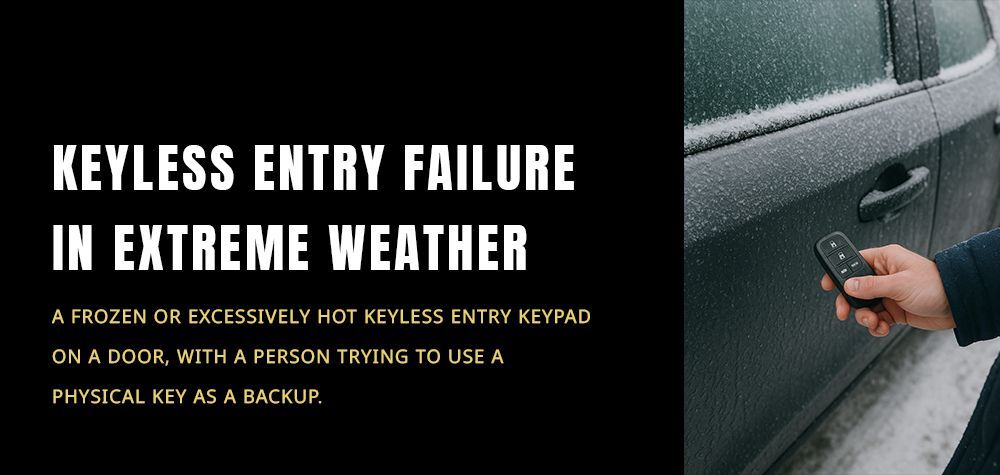Why Car Locks Freeze in Winter and How to Prevent It
There’s nothing quite as frustrating as heading out on a frosty morning—coffee in hand, ready to tackle the day—only to find that your car lock is frozen shut. You jiggle the key, try the handle, maybe even breathe warm air on it, but it won’t budge. Sound familiar?
Frozen car locks are one of winter’s most annoying little surprises. But beyond the irritation, they can also pose real risks—especially if you’re stranded in a remote area or rushing to an urgent appointment. The good news? With a little knowledge and some simple precautions, you can prevent this chilly issue before it happens.
Let’s break down why car locks freeze, what risks come with it, and—most importantly—what you can do to stop it from happening again.
"Car Lock Repairs After a Break-In: What You Need to Know"
Why Do Car Locks Freeze in the First Place?
At its core, a frozen car lock is all about moisture and temperature. Car door locks are small, enclosed spaces with tiny moving parts. When water—from rain, melted snow, or even humidity—gets into the lock mechanism and temperatures drop below freezing, that moisture turns to ice.
This ice can block the keyhole, jam the lock’s tumblers, or freeze the internal latch completely, making it impossible to turn the key or open the door. The colder it gets, the worse the problem becomes.
Modern cars with remote keyless entry can also suffer—sometimes the electronic lock motor or latch mechanism inside the door freezes, rendering the fob useless too.
The Hidden Risks of Frozen Car Locks
You might think a frozen lock is just an inconvenience, but it can quickly lead to bigger problems:
You Could Damage the Lock
Forcing a key into an iced-over lock or trying to twist it can bend or break the key—or worse, damage the internal pins and tumblers of the lock. This can lead to costly repairs or total lock replacement.
You Might Get Locked Out in Dangerous Conditions
In extremely cold weather, getting locked out of your vehicle can be more than just annoying. It can be dangerous—especially if you’re far from help, underdressed for the weather, or with children in tow.
Moisture Leads to Rust and Corrosion
Repeated freeze-thaw cycles inside your lock can lead to rust buildup. Rust doesn’t just slow down the mechanism—it can destroy it over time.
How to Prevent Car Locks from Freezing
Here’s the good part: you don’t have to wait until your lock freezes to take action. There are several ways to winter-proof your car locks so you’re never left jiggling a frozen key again.
1. Keep Your Locks Dry
Prevention starts with keeping water out of the lock in the first place. Avoid splashing water directly onto the doors and keyholes when washing your car in winter. And if you notice condensation or rain getting in around your door seals, have those checked—worn seals can let moisture creep into the lock housing.
2. Use a Lock Lubricant Before the Freeze
A dry lock lubricant like graphite powder or a silicone-based spray can coat the lock’s internal parts and help repel moisture. Apply it to each lock before freezing weather sets in, and reapply every few weeks during winter. Avoid oil-based lubricants—they can actually trap moisture inside.
3. Cover Your Car
If you have a garage, use it. If not, consider using a weatherproof car cover, especially during snowstorms. This adds a protective barrier and reduces the chances of freezing rain or snow getting into your locks.
4. Protect with a Keyhole Cover or Tape
For older cars with visible keyholes you rarely use, a simple waterproof tape or rubber keyhole cover can block snow and sleet from entering. Just remember to remove it before trying to unlock the door.
What to Do If Your Car Lock Freezes
Okay, so despite your best efforts, your lock has frozen. Now what?
Step 1: Don’t Force It
Trying to twist a key in a frozen lock can cause more damage than you think. Take a breath, step back, and try a safer approach.
Step 2: Warm the Key
If you have a metal key, try warming it with your hands, a lighter, or hairdryer (if you’re home). Gently insert the warmed key into the lock and wait a few seconds to let the heat transfer before turning.
Step 3: Use a Commercial De-Icer
Lock de-icers are specially formulated liquids that melt ice inside locks quickly. Keep a bottle handy in your home or coat pocket during the winter months—not inside the frozen car!
Step 4: Try Hand Sanitizer (Yes, Really!)
In a pinch, hand sanitizer with high alcohol content can help melt ice. Apply a bit to your key and insert it slowly. The alcohol helps lower the freezing point of water inside the lock.
When to Call a Locksmith
If the lock remains jammed despite trying everything—or if you’ve accidentally snapped your key—it’s time to call a professional automotive locksmith.
A qualified locksmith can:
Safely defrost and open your vehicle
Inspect and repair any lock damage
Apply professional-grade lubrication
Offer long-term solutions like replacing old locks or installing remote entry systems
Upgrade Your Locks for Winter Resilience
If you’ve faced frozen locks more than once, it might be time for an upgrade. Ask your locksmith about cold-weather-friendly lock systems or installing remote keyless entry to reduce your reliance on physical keyholes altogether.
Remote start systems can also warm your car before you step outside, reducing overall freezing inside the mechanism.
Conclusion: Freeze Less, Drive More
Winter brings enough challenges—don’t let frozen car locks be one of them. By understanding what causes locks to freeze and taking preventive steps before the temperature drops, you can stay one step ahead of the cold.
Remember: A frozen lock isn’t just a winter inconvenience—it’s a security risk, a time-waster, and a potential repair bill waiting to happen.
Take action early, drive smart, and if things ever do freeze up, trust a professional locksmith to get you back on the road safely.
Call Us Any Time!







